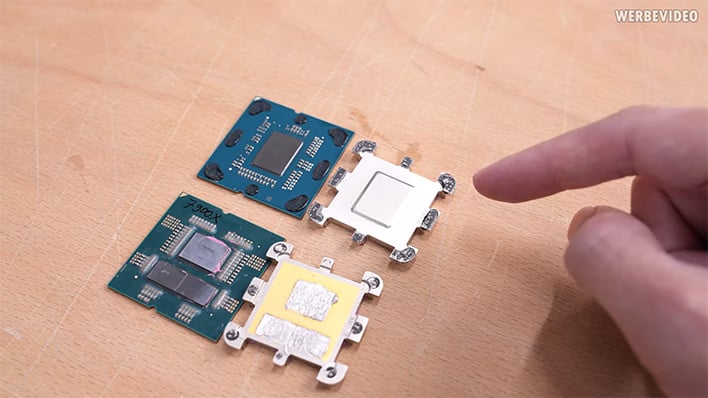Delidded AMD Ryzen 8700G Hits All-Core 5GHz Speeds, iGPU Overclocked To 3.5GHz

Popular German overclocker der8auer delided a Ryzen 7 8700G to see what untapped performance could be squeezed out of AMD’s latest Zen 4 APU. He found that delidding the chip and replacing the stock thermal interface material with better alternatives resulted in significantly better thermals, and was able to overclock the 8700G's CPU cores to 5.3GHz, achieving performance similar to AMD’s faster Ryzen 7 7700X. He was also able to take the integrated Radeon GPU's frequency up to 3.5GHz.
Delidding is the process of removing a CPU’s integrated heatspreader (IHS) for the purposes of improving cooling performance. There are multiple ways you can take advantage of delidding, either by removing the IHS entirely to cool the CPU die directly, otherwise known as direct die cooling, or re-pasting the IHS with a higher-quality thermal interface material.
Der8auer found that delidding the 8700G was much easier than delidding AMD’s Ryzen 7000 series CPUs. This is due to the fact that the Ryzen 8000G series uses a thermal compound between the CPU die and the IHS, whereas the Ryzen 7000 series features a soldered on IHS, which is more efficient and performant, but also more diffucult to break loose.
Another difference is that the Ryzen 8000G series utilizes a single monolithic die instead of the multi-chiplet design found in the Ryzen 7000 series. Both the Ryzen 7000 and Ryzen 8000G series share the same Zen 4 CPU architecture, but they are built differently have different integrated graphics configurations. AMD is using a monolithic die because the 8000G series is a direct variation of its mobile mobile CPUs, where power and real estate are at a premium.

AMD Zen 4 CPU's Delidded: Ryzen 9 7950X on the bottom, Ryzen 7 8700G on top
While testing, Der8auer found that the Cryosheet was able to significantly drop temps in Cinebench R23, going from 75°C in stock form down to just 65°C. With PBO enabled, similar thermal improvements were observed,with the chip going from 85°C stock down to around 70-75°C with the Cryosheet installed. With liquid metal, the 8700G’s thermal characteristics improved even more. With PBO-disabled temperatures came down as low as 55°C in Cinebench R23, and with PBO enabled, temps hovered around 65°C.
The thermal improvements with both the Cryosheet and liquid metal are quite impressive. But with the liquid metal configuration, Der8auer was able to overclock the 8700G an additional 300MHz — from 5GHz all-core to 5.3GHz all-core -- thanks to the extra cooling performance, surpassing the all-core frequency of a Ryzen 7 7700X.


